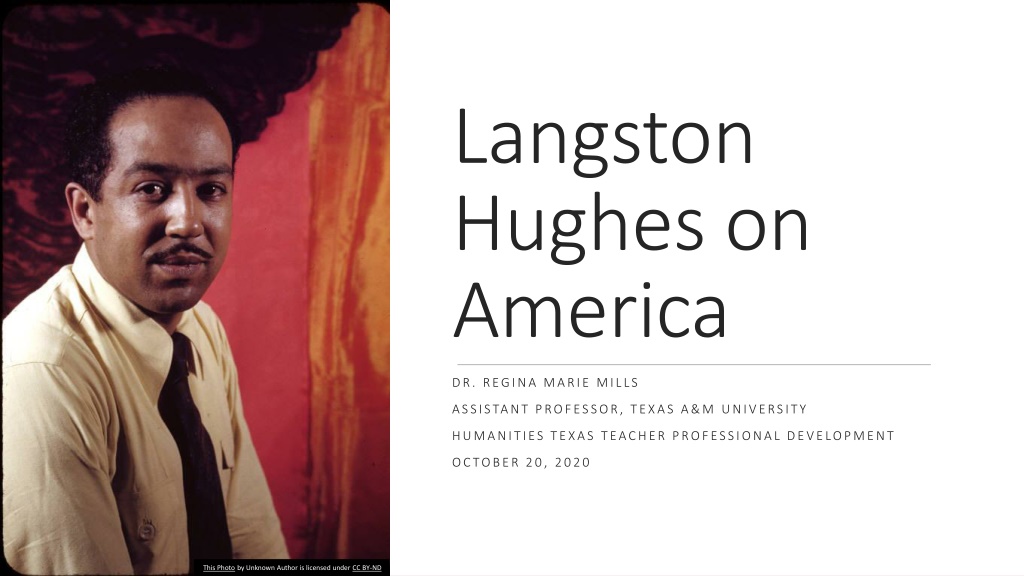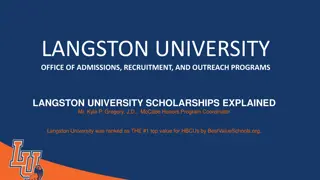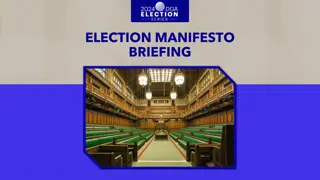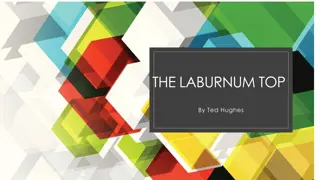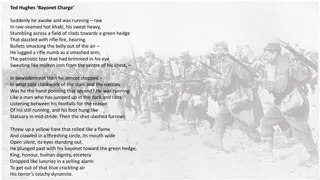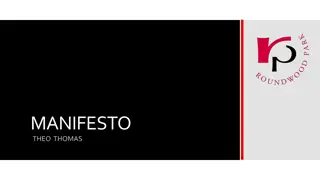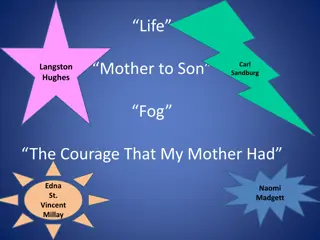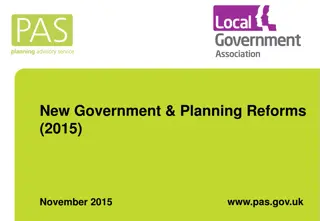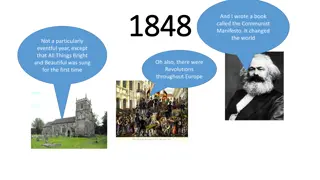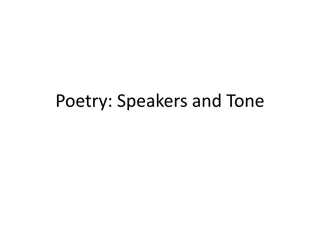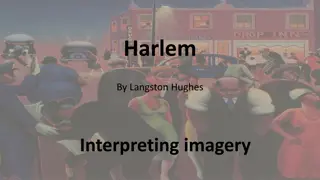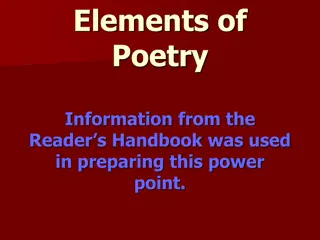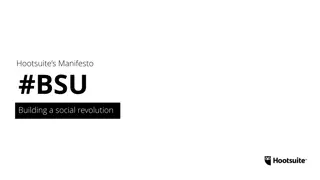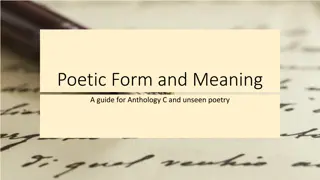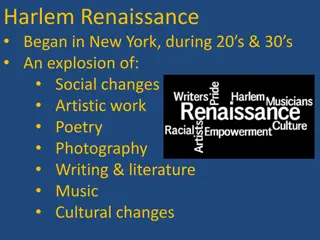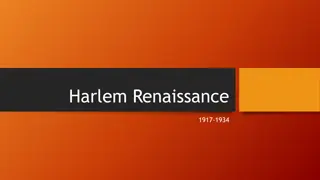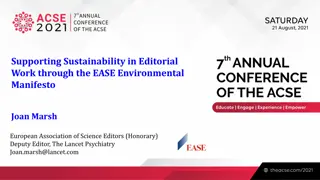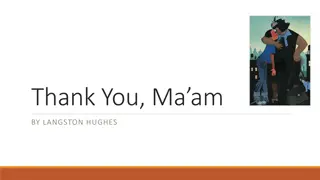Exploring Langston Hughes and His Manifesto on Art and Identity
Langston Hughes, a key figure of the Harlem Renaissance, was a versatile writer known for his poetry, plays, and novels. This article delves into his life, focusing on his seminal work "The Negro Artist and the Racial Mountain." Published in 1926 as a response to contemporary challenges faced by African American artists, the manifesto reflects Hughes' stance on art, race, and identity. Through an analysis of Hughes' background, career, and literary contributions, readers gain insight into the complex intersection of art and social commentary during Hughes' time.
Download Presentation

Please find below an Image/Link to download the presentation.
The content on the website is provided AS IS for your information and personal use only. It may not be sold, licensed, or shared on other websites without obtaining consent from the author. Download presentation by click this link. If you encounter any issues during the download, it is possible that the publisher has removed the file from their server.
E N D
Presentation Transcript
Langston Hughes on America DR. REGINA MARIE MILLS ASSISTANT PROFESSOR, TEXAS A&M UNIVERSITY HUMANITIES TEXAS TEACHER PROFESSIONAL DEVELOPMENT OCTOBER 20, 2020 This Photo by Unknown Author is licensed under CC BY-ND
ELA TEKS The lecture and workshop today could be used to teach the following TEKS: 7E (Multiple genres): analyze characteristics and structural elements of argumentative texts such as: (i) clear arguable claim, appeals, and convincing conclusion; (ii) various types of evidence and treatment of counterarguments, including concessions and rebuttals; and (iii) identifiable audience or reader 8 (Author s purpose and craft): all parts
Langston Hughes (1902- 1967)
Langston Hughes Hughes was born and raised in the Midwest but lived most of his adult life in Harlem. A prolific writer throughout his life First published poem, The Negro Speaks of Rivers when he was 19 His finances were dependent on patrons (upper class people who would support artists) and writing for survival, as he couldn t get the money or prestige of white writers. Poet to Patron
One of the most well-known artists of the Harlem Renaissance Top 3 Things to Know about Langston Hughes Known primarily for his poetry but he was also a playwright (writer of drama/theater/plays), serial writer, and novelist. Writer of the working-class
Langston Hughes Hughes wrote in a variety of genres but today we ll focus on two: The Manifesto The Negro Artist and the Racial Mountain Poetry (for the workshop portion) Formula and Call to Creation
The Negro Artist and the Racial Mountain (The Nation, 1926)
Context of Hughes Manifesto published in The Nation in June 1926 a response to George Schuyler s The Negro-Art Hokum published the week before Hughes was early in his career, attending college at Lincoln University (PA) when the manifesto was published. Had recently published his first book of poetry, The Weary Blues (1926) Manifesto: a document of an ideology, crafted to convince and convert (Mary Ann Caws, Manifesto: a Century of Isms)
Manifesto as Genre 10 min A manifesto is a form of nonfiction a public declaration which points out an issue in society and puts forward a solution to that issue. While often considered political (ex. Communist Manifesto), there have been many important art manifestos. There are many structures that manifestos follow such as the list of grievances (ex. Declaration of Independence), which identifies the problems or complaints that a group has against another group and the proposed solution. Art manifestos play with language, engage with other ideas and definitions of art, and put forth important questions to the art community. Art manifestos answer questions like, what is the purpose of art? or what is the role of the artist in society? or how can art affect the society at large?
Hughes on Art The manifesto genre and its role in art Class, race, and art What is the racial mountain ? What does American mean? What does Black mean? What were the values of the artistic movement within the Harlem Renaissance?
The Hook One of the most promising of the young Negro poets said to me once, "I want to be a poet--not a Negro poet," meaning, I believe, "I want to write like a white poet"; meaning subconsciously, "I would like to be a white poet"; meaning behind that, "I would like to be white." And I was sorry the young man said that, for no great poet has ever been afraid of being himself. And I doubted then that, with his desire to run away spiritually from his race, this boy would ever be a great poet.
Context of Hughes Manifesto Hook The young Negro poet is Countee Cullen Cullen s 1924 quote from the Brooklyn Eagle: If I am going to be a poet at all, I m going to be POET, not NEGRO POET. This is what has hindered the development of artists among us. Their one note has been the concern with their race. That is all very well, none of us can get away from it. I cannot at times. You will see it in my verse. The consciousness of this is too poignant at times. I cannot escape it. But what I mean is this: I shall not write of negro subjects for the purpose of propaganda. That is not what a poet is concerned with. Of course, when the emotion rising out of the fact that I am a negro is strong, I express it. But that is another matter.
What is the Racial Mountain? But this is the mountain standing in the way of any true Negro art in America--this urge within the race toward whiteness, the desire to pour racial individuality into the mold of American standardization, and to be as little Negro and as much American as possible.
Class and the Racial Mountain The Middle class: people who are by no means rich yet never uncomfortable nor hungry--smug, contented, respectable folk, members of the Baptist church. The Upper class: For racial culture the home of a self-styled "high-class" Negro has nothing better to offer. Instead there will be perhaps more aping of things white than in a less cultured or less wealthy home. The Lower class: But then there are the low-down folks, the so-called common element, and they are the majority--may the Lord be praised! [ ] They furnish a wealth of colorful, distinctive material for any artist because they still hold their own individuality in the face of American standardization.
What should Black American art value? What is unique to blackness jazz, blues, spirituals Freedom and Racial Pride not the approval of white gatekeepers or middle/upper-class Black people The full humanity of Black people We know we are beautiful. And ugly too.
Bonus Jesse B. Semple Stories If you re interested in teaching students about serials and examining stories with attention to narration and characterization, the Simple stories are a great text to use. Banquet in Honor can be paired well with The Negro Artist and the Racial Mountain I ve also included other stories I enjoy teaching Here you can find 4 stories narrated by Ossie Davis.
Q&A FEEL FREE TO CONTACT ME AT RMILLS@TAMU.EDU IF YOU THINK OF ADDITIONAL QUESTIONS
Workshop Anticipation Question: What do you think poetry is supposed to do? What purpose does it have? (this is also a useful question for students)
Discussion Questions What argument does the poem Formula make about what poetry is or should do? How does Formula compare to Call to Creation do they have similar or different views? Call to Creation, published in 1931, mentions several countries outside of the US. What purpose do you think this serves? Is there anything you want to look up about the time period or Hughes that you think would help you understand the poem better? As teachers, what other poets or poems do you think might be useful to pair with these ars poetica pieces?
